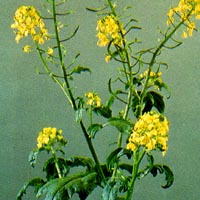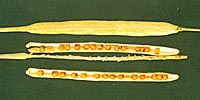
Mustard was one of the first crops domesticated by man. The English name, mustard, is derived from the Latin mustum or must which is the expressed juice of grapes and ardens meaning "hot" or "burning". Mustards are a versatile group of plants which were used historically in a variety of ways. The tender plants were cooked and eaten as a green or fed to sheep and the young shoots eaten in salads. The seeds were used by a variety of cultures in food, and were valued for their flavoring, medicinal, and preservative value. Early mention of mustard is made by Pythagoras in 530 BC as a remedy for scorpion bites. The Romans mixed must with crushed mustard seed to form a paste known as mustum ardens. The Romans love of mustard carried the seed with them throughout Europe where it became popular as a seasoning for meat and fish. Mustard was used in China and Egypt for flavoring food; some say it was used to disguise the taste of degraded perishables. Egyptians entombed their kings with a supply of mustard seed for the afterlife.
Most mustard in the early days was prepared by pounding the seeds in a mortar and moistening them with vinegar. Monasteries and royal households had an official "mustardarius" whose special task it was to select the seeds and prepare the mustard. Pope John XXII - the world's first official mustard lover - gave his nephew the title of Premier Moutardier du Pape - "Mustard Maker for the Pope." Dijon, France is credited with producing the first really palatable mustard by using "verjus", a unique grape juice of the Bourgogne region.
As storage and culinary techniques advanced, condiments and spices were no longer necessary to mask the taste of spoiled food. But mustard remained a popular flavoring. Over the years, several "mustard firms" began processing the seed, creating such mustards Dijon (founded in the 1700's by Monsieur Grey and Monsieur Poupon). Other entrepreneurs experimented with combining various types of mustard seeds, such as black and yellow, to create a superb mustard powder exported throughout the world. French's mustard had its start in New York. French's Cream Salad Mustard made its debut with the hot dog at the 1904 St. Louis World's Fair.
Today, there are countless mustard variations available on the market, each reflecting local, regional and national cuisine. The growing number of small independent manufacturers has created a new market for unique blends combining mustard with fruit, spirits, herbs, vegetables, and honey.

The two species of mustard involved in condiment production are Sinapis alba (white or yellow mustard, shown left) and Brassica juncea (brown and oriental mustards). Mustard is related to rapeseed and the two closely resemble each other. They can share the same growing
areas, although mustard is more resistant to dry conditions than
is canola.
Why is it produced?
Mustard is used primarily in the production of dry (39%) and prepared mustards(61%). Dry mustard is extensively used as an ingredient in mayonnaise, salad dressings and sauces. Mustard is used in small amounts to flavor many foods including condiments and seasonings, relishes and a variety of baked goods.
- In mayonnaise, it's natural emulsifying property inhibits oil separation as well as adding flavor.
- In processed meats and sausages it acts as a binding agent as well as a flavor enhancer.
- Mustard is considered an essential ingredient of authentic French dressing, Hollandaise sauce, and salad dressing.
- A traditional picking spice, recent research confirms it helps reduce the formation of scum at the top of the pickling crock.
- It can be used to create heat in spicy dishes where, unlike the heat from pepper and chilies, it dissipates rapidly in the mouth, thus allowing the appreciation of other dishes.
Three species of mustard are responsible for the seed used as a spice and condiment, white or yellow, brown, and black.
- Yellow seeds - are derived from Brassica hirta and are a pale yellow with a pinkish cast. They are used to make the milder flavored prepared mustards. Yellow mustard flour is an excellent emulsifying agent and stabilizer and the ground product is widely used in sausage preparation.
- Brown and black seeds - Brassica juncea is responsible for brown mustard and Brassica nigra for black. Both black and brown mustard seed is reddish brown to dark brown in color and the flavor and constituents of each of are very similar. Black was universally used prior to the 1940's when brown began to gradually replace it because it was better suited to mechanized production.
Oriental and Brown mustards are grown as oilseed crops in some parts of the world, but in Canada and the United States, production is only as a spice.
All three species of mustard contain an enzyme, myrosin, which breaks down a glucoside to produce the oil responsible for the distinctive sharp mustard flavor. The enzyme activity is blocked by too much heat, by an acidic pH, or large amounts of salt. Thus, mustard should be mixed with warm water (or other non-acidic liquid) for ten minutes before adding to foods. Once the oil is released, it dissipates or changes quickly in brown and black mustard, more slowly in yellow. Therefore, the moistened mustard should be used soon or stored in a tightly covered container in the refrigerator. The addition of vinegar, lemon juice, or wine stops the enzyme activity and helps to preserve the flavor.
The quality of whole mustard seed is determined by the quantity of mature, undamaged seeds. Ground mustard quality is dependent on it's final use. Mustard is available as various mixtures of ground seeds, with or without the bran or hull of the seed, at a variety of different heat and pungency levels.
Where is mustard produced in Saskatchewan?
Mustard is a cool season crop well suited to a short growing season (90 to 110 days to maturity). Mustard will germinate at a soil temperature as low as 4.4oC and the seedlings are quite frost and tolerant. Mustard is grown in the drier regions of Saskatchewan because of the better seed quality obtained under these conditions. It is well adapted to the Brown and Dark Brown soils of the prairies. Mustard plants prefer well aerated soils that do not become waterlogged and are drought tolerant. Poor aeration in the root zone will permanently stunt their growth. Mustard performs best in soil with a near neutral pH (pH 7) but will tolerate alkaline (above pH7) and slightly saline soils. Mustard's tolerance to saline soils is similar to that of barley.
The mustards are not used in general farming or in rotation with annual crops because most types produce some hard seed which will remain dormant in the soil and can cause weed problems in following crops.
How much do we produce?
The area of Saskatchewan seeded to mustard in 1995 was 550,000 acres; the production of mustard has declined in recent years.
What does it look like?
Mustards are members of the cruciferaceae family; and, as annuals, they grow wild and are cultivated throughout the temperate zones of the world. Mustards are stemmy herbs and produce dense, heavy growth with bright yellow flowers appearing 3-5 weeks after sowing. The plants vary in size from 1 foot to 6 feet depending on the species. Mustard taproots extend to depths of 1-3 feet. Most, if not all species, produce some hard seed. Most of the mustard used in the United States is grown in the Western Prairie Provinces of Canada or in the Dakotas and Montana.
Yellow mustard varieties are large seeded, and the seed is light yellow in color. The yield of yellow mustard is, on average, 30 percent less than that of Oriental mustard. Differences in yield between the different types of mustard is normally compensated for by price.
How is it produced?
Mustard is grown and harvested on a large commercial scale much like other grain crops. Some degree of dryness (as in the brown and black soil zones) appears to produce a better quality seed for the intended condiment market. Most is grown under contract, since demand in the condiment market
has limitations. All the mustards are resistant to the blackleg disease. Most varieties require 94 to 96 days to maturity.
Oriental and Brown mustards are usually swathed, but straight combining is also possible. Yellow mustard should be straight combined because of possible losses due to wind damage to the fluffy swath. |
